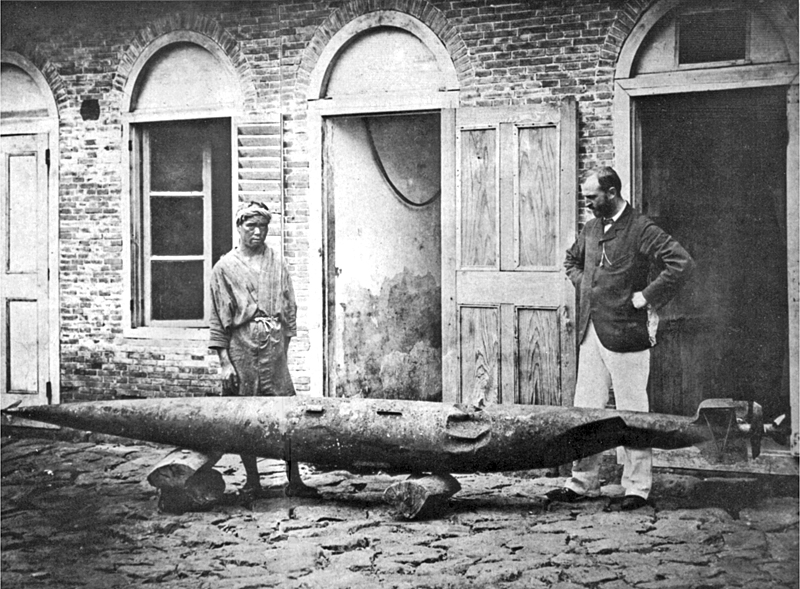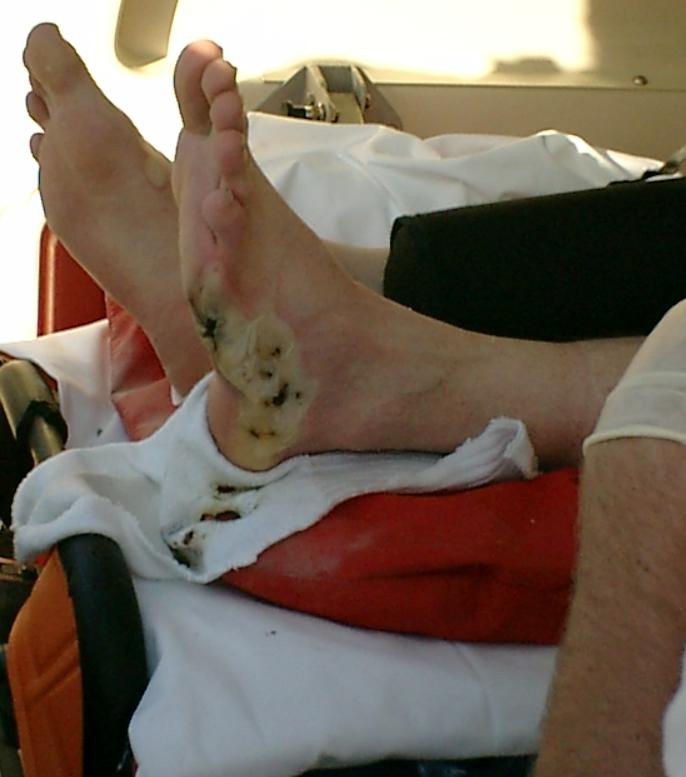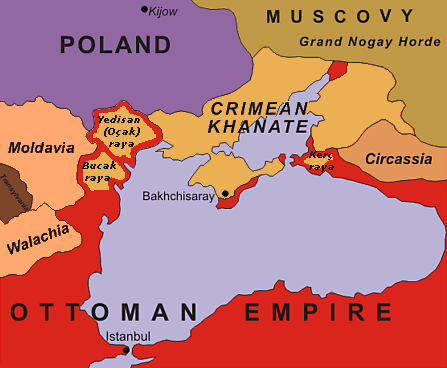|
Whitehead Torpedo
The Whitehead torpedo was the first self-propelled or "locomotive" torpedo ever developed. It was perfected in 1866 by British engineer Robert Whitehead from a rough design conceived by Giovanni Luppis of the Austro-Hungarian Navy in Fiume. It was driven by a three-cylinder compressed-air engine invented, designed, and made by Peter Brotherhood. Many naval services procured the Whitehead torpedo during the 1870s, including the US Navy. This early torpedo proved itself in combat during the Russo-Turkish War when, on 16 January 1878, the Ottoman ship ''Intibah'' was sunk by Russian torpedo boats carrying Whiteheads, though this story has been disputed in one book. The term "torpedo" comes from the torpedo fish, which is a type of ray that delivers an electric shock to stun its prey. History During the 19th century, an officer of the Austrian Marine Artillery conceived the idea of using a small boat laden with explosives, propelled by a steam or an air engine and steere ... [...More Info...] [...Related Items...] OR: [Wikipedia] [Google] [Baidu] |
Austria-Hungary
Austria-Hungary, also referred to as the Austro-Hungarian Empire, the Dual Monarchy or the Habsburg Monarchy, was a multi-national constitutional monarchy in Central Europe#Before World War I, Central Europe between 1867 and 1918. A military and diplomatic alliance, it consisted of two sovereign states with a single monarch who was titled both the Emperor of Austria and the King of Hungary. Austria-Hungary constituted the last phase in the constitutional evolution of the Habsburg monarchy: it was formed with the Austro-Hungarian Compromise of 1867 in the aftermath of the Austro-Prussian War, following wars of independence by Hungary in opposition to Habsburg rule. It was dissolved shortly after Dissolution of Austria-Hungary#Dissolution, Hungary terminated the union with Austria in 1918 at the end of World War 1. One of Europe's major powers, Austria-Hungary was geographically the second-largest country in Europe (after Russian Empire, Russia) and the third-most populous (afte ... [...More Info...] [...Related Items...] OR: [Wikipedia] [Google] [Baidu] |
Torpedo Boat
A torpedo boat is a relatively small and fast naval ship designed to carry torpedoes into battle. The first designs were steam-powered craft dedicated to ramming enemy ships with explosive spar torpedoes. Later evolutions launched variants of self-propelled Whitehead torpedoes. These were inshore craft created to counter both the threat of battleships and other slow and heavily armed ships by using speed, agility, and powerful torpedoes, and the overwhelming expense of building a like number of capital ships to counter an enemy. A swarm of expendable torpedo boats attacking en masse could overwhelm a larger ship's ability to fight them off using its large but cumbersome guns. A fleet of torpedo boats could pose a similar threat to an adversary's capital ships, albeit only in the coastal areas to which their small size and limited fuel load restricted them. The introduction of fast torpedo boats in the late 19th century was a serious concern to the era's naval strategists, i ... [...More Info...] [...Related Items...] OR: [Wikipedia] [Google] [Baidu] |
Prey
Predation is a biological interaction in which one organism, the predator, kills and eats another organism, its prey. It is one of a family of common feeding behaviours that includes parasitism and micropredation (which usually do not kill the host) and parasitoidism (which always does, eventually). It is distinct from scavenging on dead prey, though many predators also scavenge; it overlaps with herbivory, as seed predators and destructive frugivores are predators. Predation behavior varies significantly depending on the organism. Many predators, especially carnivores, have evolved distinct hunting strategies. Pursuit predation involves the active search for and pursuit of prey, whilst ambush predators instead wait for prey to present an opportunity for capture, and often use stealth or aggressive mimicry. Other predators are opportunistic or omnivorous and only practice predation occasionally. Most obligate carnivores are specialized for hunting. They may ha ... [...More Info...] [...Related Items...] OR: [Wikipedia] [Google] [Baidu] |
Electric Shock
An electrical injury (electric injury) or electrical shock (electric shock) is damage sustained to the skin or internal organs on direct contact with an electric current. The injury depends on the Current density, density of the current, tissue resistance and duration of contact. Very small currents may be imperceptible or only produce a light tingling sensation. However, a shock caused by low and otherwise harmless current could startle an individual and cause injury due to jerking away or falling. A strong electric shock can often cause painful Spasm, muscle spasms severe enough to Joint dislocation, dislocate joints or even to Bone fracture, break bones. The loss of muscle control is the reason that a person may be unable to release themselves from the electrical source; if this happens at a height as on a Overhead power line, power line they can be thrown off. Larger currents can result in tissue damage and may trigger ventricular fibrillation or cardiac arrest. If death res ... [...More Info...] [...Related Items...] OR: [Wikipedia] [Google] [Baidu] |
Ray (fish)
Batomorphi is a division of cartilaginous fishes, commonly known as rays, this taxon is also known as the superorder Batoidea, but the 5th edition of ''Fishes of the World'' classifies it as the division Batomorphi. They and their close relatives, the sharks, compose the subclass Elasmobranchii. Rays are the largest group of cartilaginous fishes, with well over 600 species in 26 families. Rays are distinguished by their flattened bodies, enlarged pectoral fins that are fused to the head, and gill slits that are placed on their ventral surfaces. Anatomy Batomorphs are flat-bodied, and, like sharks, are cartilaginous fish, meaning they have a boneless skeleton made of a tough, elastic cartilage. Most batomorphs have five ventral slot-like body openings called gill slits that lead from the gills, but the Hexatrygonidae have six. Batomorph gill slits lie under the pectoral fins on the underside, whereas a shark's are on the sides of the head. Most batomorphs have a flat, ... [...More Info...] [...Related Items...] OR: [Wikipedia] [Google] [Baidu] |
Torpedo Fish
The electric rays are a group of rays, flattened cartilaginous fish with enlarged pectoral fins, composing the order Torpediniformes . They are known for being capable of producing an electric discharge, ranging from 8 to 220 volts, depending on species, used to stun prey and for defense. There are 69 species in four families. Perhaps the best known members are those of the genus ''Torpedo''. The torpedo undersea weapon is named after it. The name comes from the Latin , 'to be stiffened or paralyzed', from the effect on someone who touches the fish. Description Electric rays have a rounded pectoral disc with two moderately large rounded-angular (not pointed or hooked) dorsal fins (reduced in some Narcinidae), and a stout muscular tail with a well-developed caudal fin. The body is thick and flabby, with soft loose skin with no dermal denticles or thorns. A pair of kidney-shaped electric organs are at the base of the pectoral fins. The snout is broad, large in the Narcinidae, b ... [...More Info...] [...Related Items...] OR: [Wikipedia] [Google] [Baidu] |
Imperial Russian Navy
The Imperial Russian Navy () operated as the navy of the Russian Tsardom and later the Russian Empire from 1696 to 1917. Formally established in 1696, it lasted until being dissolved in the wake of the February Revolution and the declaration of the Russian Republic in 1917. It developed from a smaller force that had existed prior to Tsar Peter the Great's founding of the modern Russian navy during the Azov campaigns (1695–1696), Second Azov campaign in 1696, and expanded in the second half of the 18th century before reaching its peak strength by the early part of the 19th century, behind only the British and French fleets in terms of size. The Imperial Navy drew its officers from the aristocracy of the Empire, who belonged to the state Russian Orthodox Church. Young aristocrats began to be trained for leadership at a national naval boarding school, the Naval Cadet Corps (Russia), Naval Cadet Corps. From 1818 on, only officers of the Imperial Russian Navy were appointed to the p ... [...More Info...] [...Related Items...] OR: [Wikipedia] [Google] [Baidu] |
Russo-Turkish War (1877–78)
The Russo-Turkish wars ( ), or the Russo-Ottoman wars (), began in 1568 and continued intermittently until 1918. They consisted of twelve conflicts in total, making them one of the longest series of wars in the history of Europe. All but four of these wars ended in losses for the Ottoman Empire, which was undergoing a period of stagnation and decline. Conversely, they showcased the ascendancy of the Russian Empire as a significant European power after Peter the Great oversaw extensive modernization efforts in the early 18th century. Ultimately, however, the end of the Russo-Turkish wars came about with the dissolution of the two belligerents' respective states as a consequence of World War I: the Russian Empire collapsed in 1917 and was ultimately succeeded by the Union of Soviet Socialist Republics in 1922; while the Ottoman Empire was partitioned between 1918 and 1922 and succeeded by the Republic of Turkey in 1923. History Initial and intermediate phases (1568–1739) ... [...More Info...] [...Related Items...] OR: [Wikipedia] [Google] [Baidu] |
US Navy
The United States Navy (USN) is the naval warfare, maritime military branch, service branch of the United States Department of Defense. It is the world's most powerful navy with the largest Displacement (ship), displacement, at 4.5 million tons in 2021. It has the world's largest aircraft carrier fleet, with List of aircraft carriers in service, eleven in service, one undergoing trials, two new carriers under construction, and six other carriers planned as of 2024. With 336,978 personnel on active duty and 101,583 in the Ready Reserve, the U.S. Navy is the third largest of the United States military service branches in terms of personnel. It has 299 deployable combat vessels and about 4,012 operational aircraft as of 18 July 2023. The U.S. Navy is one of six United States Armed Forces, armed forces of the United States and one of eight uniformed services of the United States. The United States Navy traces its origins to the Continental Navy, which was established during ... [...More Info...] [...Related Items...] OR: [Wikipedia] [Google] [Baidu] |
Peter Brotherhood
Peter Brotherhood (1838–1902) was an English engineer. He invented the Brotherhood engine used for torpedoes as well as many other engineering products. With his son he built a large engineering business in London bearing his name, Peter Brotherhood. His son Stanley moved the works to Peterborough in 1903 where their engineering business continued to grow. On 30 October 2015 Hayward Tyler Group PLC completed the acquisition of the trade and assets of the Peter Brotherhood business from Dresser-Rand Group, Dresser-Rand Company Ltd, a Siemens-owned company. Family of engineers Brotherhood was the second son of the 14 children of Priscilla (née Penton) and Rowland Brotherhood (1812-1883), an English engineer. He was born in Maidenhead, Berkshire on 22 April 1838 and raised in comfortable circumstances in Chippenham, Wiltshire near his father's engineering works. From the ages of 13 to 18, he studied applied science at King's College School. After practical experience including ... [...More Info...] [...Related Items...] OR: [Wikipedia] [Google] [Baidu] |
Fiume
Rijeka (; Fiume ( �fjuːme in Italian and in Fiuman Venetian) is the principal seaport and the third-largest city in Croatia. It is located in Primorje-Gorski Kotar County on Kvarner Bay, an inlet of the Adriatic Sea and in 2021 had a population of 107,964 inhabitants. Historically, because of its strategic position and its excellent deep-water port, the city was fiercely contested, especially between the Holy Roman Empire, Venice, Italy and Yugoslavia, changing rulers and demographics many times over centuries. According to the 2011 census data, 85% of its citizens are Croats, along with small numbers of Serbs, Bosniaks and Italians. Rijeka is the main city and county seat of the Primorje-Gorski Kotar County. The city's economy largely depends on shipbuilding (shipyards " 3. Maj" and " Viktor Lenac Shipyard") and maritime transport. Rijeka hosts the Croatian National Theatre Ivan pl. Zajc, first built in 1765, as well as the University of Rijeka, founded in 1973 but ... [...More Info...] [...Related Items...] OR: [Wikipedia] [Google] [Baidu] |
Austro-Hungarian Navy
The Austro-Hungarian Navy or Imperial and Royal War Navy (, in short ''k.u.k. Kriegsmarine'', ) was the navy, naval force of Austria-Hungary. Ships of the Austro-Hungarian Navy were designated ''SMS'', for ''Seiner Majestät Schiff'' (His Majesty's Ship). The k.u.k. Kriegsmarine came into being after the formation of Austria-Hungary in 1867, and ceased to exist in 1918 upon the Empire's defeat and subsequent collapse at the end of World War I. Before 1867, the Imperial Austrian Navy or simply the Austrian Navy, saw action in the French Revolutionary Wars, the Napoleonic Wars, the Austrian expedition against Morocco (1829), the Second Egyptian–Ottoman War, the First Italian War of Independence, First and Second Italian War of Independence, Second Italian unification, Wars of Italian Independence, the Second Schleswig War, and the Third War of Italian Independence. Following Austria's defeat by Prussia and Italy during the Seven Weeks' War, the Austrian Empire Austro-Hungarian C ... [...More Info...] [...Related Items...] OR: [Wikipedia] [Google] [Baidu] |






